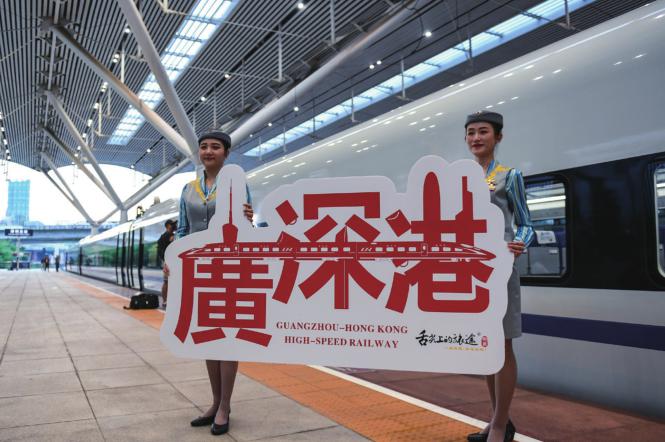Bay,Bay,on the Way
2019-03-10ByYuanYuan
By Yuan Yuan

Huang Yuanhao, an entrepreneur in Shenzhen, south Chinas Guangdong Province, was very happy to see that a clip of his recent interview was included in a major daily news program broadcast on China Central Television on February 18.
The piece was shown with the announcement of the release of an outline plan for the development of the GuangdongHong Kong-Macao Greater Bay Area (Greater Bay Area), which incorporates nine cities in Guangdong, namely Guangzhou, Shenzhen, Zhuhai, Foshan, Huizhou, Dongguan, Zhongshan, Jiangmen and Zhaoqing as well as the adjacent Hong Kong and Macao special administrative regions (SAR).
Issued by the Central Committee of the Communist Party of China and the State Council, Chinas cabinet, it is the next major regional development plan following Xiongan New Area in the north.
The proposal—which was fi rst introduced in the government work report delivered by Premier Li Keqiang on March 5, 2017—has finally concretized from a concept to a plan after concerted efforts over the past two years.
The southern engine
According to the plan, by 2022, the framework for an international first-class bay area and world-class city cluster should be essentially formed. By 2035, the region should become an economic system and mode of development mainly supported by innovation, fully developing into an international fi rst-class bay area for living, working and travel.
Located on the southern coast of China, the region has long been highlighted for its robust economic strength, distinctive geographical advantages and high concentration of key innovation factors.
As the founder of Orbbec, a startup fo- cusing on the development of 3D sensors, Huang expressed his support and optimism for further development of the city cluster and said different cities advantages will surely be optimized by the plan.
“Hong Kong and Macao have more advantages in talent and finance and are more internationalized,” Huang told Beijing Review. “Shenzhen has formed a complete chain for scientific and innovation industries. Dongguan and Foshan, which are both included in the plan, have mature manufacturing foundations. The plan will greatly help to optimize these resources.”
In 2013, Huang chose Shenzhen as the base for his company. “Shenzhen, as a robust innovation hub, has attracted a lot of international talent in recent years and also offers very competitive support measures in an all-around way,” Huang said. Orbbec has now developed from a small company with less than 20 people to a large fi rm with about 600 employees.
Lian Cong, Deputy Director of Nanshan District of Shenzhen, said that in the past few years, the Qianhai Shenzhen-Hong Kong Youth Innovation and Entrepreneur Hub set up by Shenzhen, has provided free marketing services and offi ce space for 6-18 months for young startups from Hong Kong and Macao.
Another nine hubs for startups will be set up in the Greater Bay Area to create more opportunities for young people to develop their own businesses.
DJI, the worlds largest commercial drone manufacturer based in Shenzhen, hopes to attract more hi-tech talent to the Greater Bay Area with the implementation of the plan, which will boost scientifi c and technological innovation and development in the region.
Chinas consumer electronics giant, TCL Corp., located in Huizhou, said it would increase investment in its research and development(R&D;) center in Hong Kong, make use of local skills and platforms, and recruit foreign employees to enhance its R&D; capacity.
In addition, Zou Hua, Deputy Director of Hengqin New Area in Zhuhai, said there are now more than 2,700 companies from Hong Kong and Macao registered in Hengqin.
Mao Yanhua, a professor at Zhongshan University in Guangzhou, said 16 state-level key labs have been set up in Hong Kong and four in Macao in recent years aimed at in- corporating the resources from both Chinas mainland and the SARs for further R&D.;
Cooperation enhanced
On July 1, 2017, the framework agreement on the development of the Greater Bay Area was signed in Hong Kong with President Xi Jinping in attendance. In 2018, the leading group for its construction was set up and held its fi rst plenary meeting on August 15.
Hong Kong, Macao, Guangzhou and Shenzhen are set to be the core engines for the regions development. Hong Kong will serve as an international fi nancial, transportation and trade center, as well as an international aviation hub; Macao will focus more on being a tourist and leisure center; Guangzhou will be an international commerce and industry center and an integrated transportation hub; and Shenzhen will strive to be a global capital of innovation and creativity. The remaining cities have been identifi ed as key node cities for the region.
Meanwhile, a package of policies was released to enhance the cooperation and talent flow in the region, while more infrastructure projects have been completed or are under construction. With the high-speed railway connecting Hong Kong, Guangzhou and Shenzhen going into operation in September 2018, it now takes passengers only 48 minutes from Guangzhou to Hong Kong, and 15 minutes from Shenzhen to Hong Kong. The mega Hong Kong-ZhuhaiMacao Bridge, opened on October 24, 2018, will play a critical role in integrating the infrastructure network in the region.
In January, Guangzhou released the Guangzhou Comprehensive Transportation Hub Plan (2018-35), which aims to enable people to fl y from Guangzhou to most major cities in the world within 12 hours in the future.
“Compared with the coordinated development of Beijing-Tianjin-Hebei, it is more diff icult to synergize Guangdong, Hong Kong and Macao since the two SARs have different systems, even though they are part of one China,” Zheng Yongnian, a researcher of East Asia studies at the National University of Singapore, told China Daily.
Zheng said that Guangdong needs to upgrade its industries and transform its growth model, while Hong Kong has encountered a development bottleneck due to the fact that almost all of its manufacturing has relocated to the Pearl River Delta, and Macao desperately needs to diversify its economic and industrial structures.
In a statement released after the outline was announced, Hong Kong SAR Chief Executive Carrie Lam Cheng Yuet-ngor expressed gratitude to the Central Government for giving importance to the views of Hong Kong SARs government while formulating the plan.
After the unveiling of the outline, Chui Sai-on, Chief Executive of Macao SAR, said that Macao is willing to deepen cooperation with other cities in the Greater Bay Area and make its own contributions to national strategic development so as to achieve greater success in terms of integration of the nations overall development.
